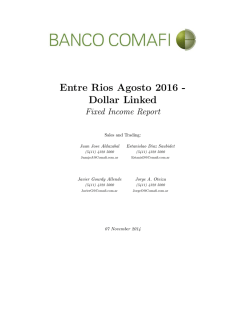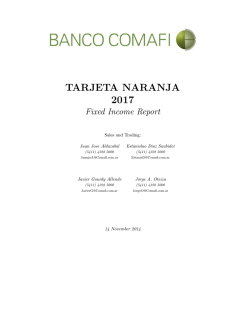
Speech
Opp portunity tto act: Making sm mart decissions in a ttime of lo ow oil prices Maria van der d Hoeven IEA Executivve Director Oxfford Energy C Colloquium 27 Jan nuary 2015 Ladies an nd Gentlemeen, Thank yo ou for inviting me to speaak to you tod day. I was pro ovided with a set of questions a few w weeks ago that I might tackle heere today. Th hey are impo ortant questio ons, no doub bt, asking whether the oill prices hs could havee been predicted, what the prospectss are for an o oil price movemeents of the paast six month recoveryy, and to whaat degree oil exploration is stranded. But with your leave I would prefeer to take a slightly differeent approach h. Because while w we can certainly out what will happen oveer the comingg year, so mu uch dependss on not only decisions make preedictions abo by key oil-producing regions, but also armed conflict and geopolitical ttensions. Insstead of riskss, I would peak about o opportunity. rather sp I would rrather speak today aboutt we can do n now. What actions can w we take, given n the precipittous drop in oil pricces that has occurred oveer the past months? m Whaat can be don ne today thatt would havee been near imp possible one year ago? W What can be d done that can n have a real and positivee impact on cclimate negotiations at COP2 21 later this yyear? Indeed d, how can we make smarrt decisions in this time o of low oil prices? © OECD/IEA, 2015 You havee all seen thee headlines. “Falling “ oil prices threateen electric cars and biofueels”, “Uncerttain economiic fortunes in n a world of ccheap oil”, “C Cheaper oil, fatter walletts and a natio onal opportu unity”, and very succcinctly “Cheaaper oil: man ny winners, a few bad losers.” It seem ms everyone h has an opinio on, and rightly so o. What happ pens to the oil o market afffects countleess aspects of human actiivity, in the rrealm of energy aand otherwise. It’s fundam mental to ou ur economiess, and will continue to plaay a critical ro ole for years to come. The IEEA’s World Energy E Outloo ok central sceenario sees o oil still provid ding one-quaarter of the nergy mix byy 2040. global en So it is understandab ble that governments, businesses, and d experts likee all of you in n this room ssee this as nt, and one w worthy of disscussion. And d for that discussion, let’ss begin with a bit of an important momen perspecttive. d like to take us back a few w years. If you’ll aallow me, I’d In the wiinter of 1901 1, a Croatian--born oil exp plorer named d Anthony Lucas hit a gusher on Spind dletop Hill, in Texas.. Almost 100,000 barrels per day begaan erupting o out of the gro ound, settingg off the Texas oil boom. Laand that had d sold for USD D 10 an acre was suddenly selling for as much as U USD 900 000 0 an acre. © OECD/IEA, 2015 But befo ore the summ mer was overr, with more than 200 weells now pumping oil, the price of oil h had dropped d to as little aas 3 cents perr barrel. Thiss was almost the price of water. Manyy investors lo ost fortuness because theey couldn’t seee where thee market wass going. Wheen the price o of oil is the same as water, do you invest in drilling riggs or oil lamp ps? Many off you probablly know this story. The hiistory of the oil industry iis rife with bo oom-and-bust cycles, below USD 50 per barrel, it seems thaat many of winners and losers. YYet as the priice of oil todaay drops to b ur history. Hisstorically thee price of oil falls, f and theen it rises. Yo ou may recall that oil us have fforgotten ou was as high as USD 1 145 in summeer of 2008. Itt was then arround USD 40 0 by Decemb ber. By summ mer 2011 it hey once were, this was backk above USD 120. While tthe peaks and valleys may be more seevere than th cycle is the t nature off the market.. The winners are the onees who take aadvantage off both the highs and the lowss. That said d, the naturee of today’s m market sell-offf, brought o on by deep im mbalances aftter years of rrecordhigh pricces, price elasticity of ligh ht tight oil, an nd OPEC goin ng for market share insteead of price, means m that marrkets will nevver again be tthe same. Next mo onth the IEA w will launch th he 2015 editiion of our Medium-Term Oil Market R Report. It pro omises to be a fasccinating read d. While you will w have to w wait a few weeks w for the full publication, suffice to say for now the IEA forecastts lower pricee assumption ns moving forward. Much h hangs on th he outcome of o talks n, violence in n oil-producin ng countries,, and future relations r bettween Russiaa and the Weest. with Iran But fund damentally, for today, thee question is not whetherr the price off oil will rise again. It will rise, though h how far is debatable. Rather the quesstion for todaay is, now thaat the price iis so low, what does it mean? O Or rather, wh hat could it m mean? What cchoices doess it enable uss to make, to take advanttage of this opportunity? Today's bear market in oil reflectts the changees in supply and a demand that were seet loose by th he bull of the last several years. The T more thaan 50% increease in U.S. o oil production n in recent yeears market o © OECD/IEA, 2015 resulted at least in paart from high h prices. Similarly, prices played a keyy role in efforrts to make ccars and onsume less fuel, which has h translated into lower growth in oiil demand wo orldwide. trucks co Some ob bservers are llikening this era to the beear market in n oil that beggan in the mid-1980s. Bacck then, policy makers in certtain countries could have taken advan ntage of the plunge in oil prices to tighten f cy standards, which would d have proteected motorissts from the inevitable ru un-up in vehicle fuel-efficienc prices. But B instead th hey generallyy took a laisseez-faire apprroach, and co onsumers flo ocked to largeer, thirstier vehicles. Wh hen oil pricess began risingg, owners of those vehicles paid dearrly at the pum mp. What a d difference a protracted p sp pell of high p prices makes. Formerlyy a laggard, the t United Sttates raised ffuel efficienccy standards ffor new lightt-duty vehiclees by more thaan 14% betw ween 2008 an nd 2013. Tho ough some in the U.S. mayy be taking aadvantage off low oil prices an nd buying SU UVs, standard ds will be tigh htened further in the years to come. TThis will redu uce US dependeence on oil byy 2 million baarrels a day b by 2025, acco ording to thee US governm ment. This will improve US energy security and curb b emissions o of the greenh house gases tthat are caussing the o warm. And if past experience offerss any lessons, now is not tthe time to eease up – esp pecially planet to given thee pressing neeed to transfform our plan net's energy system. With its heavy reliance on fossil ffuels, the currrent system is on course to deliver att least a 4-deegree ncrease in global temperatures if no cchanges are made. It is no secret thatt we need radical Celsius in action, b but efforts thus far have b been sluggish h at best. In tthe IEA’s ann nual assessment of efforts to transform m the energyy system, ren newables rep present the only o bright sp pot in an otherwise-bleakk picture of clean-en nergy progresss. And therre are importtant changess in the energgy mix for yeears to come: demand forr coal and oill continues to fall, w while natural gas and reneewables use expands veryy rapidly. And while global energy demand has grown byy one-third ssince 2000, th he IEA expeccts continued d stable energy demand in OECD coun ntries to 2040. © OECD/IEA, 2015 But that is not to sayy that we sho ould not pay attention to oil. It will co ontinue to haave a role to play in the m for yearss to come. But for today,, as we havee seen, oil maarkets are w well-supplied.. Prices are energy mix low, and d demand is slowing. Indeed we havee reduced ou ur estimate o of oil deman nd growth in 2015 by a further 2 230 000 barrrels per day.. Growth is sslowing in China, but alsso in Russia where the economy e is under prressure from sanctions an nd lower oil revenues. r But again, short-term m conditions should not d divert our atttention from m problems tthat may lie ahead. We must takke a longer-teerm view. In terms of oil supply, onlyy a few region ns show significant growtth over the next deccades: the United States, Canada, Brrazil and thee Middle Eastt. The non-O OPEC countriies make a significan nt contributiion to satisfyy growing oil demand in n the period to 2020. Bu ut after this, there is a large and d growing gaap in the maarket. This gaap needs to be filled by the only rem maining largee source of low-costt oil. That is the Middle East. There are plenty of resourcess to meet th his challengee but given security concerns and today’s oil market, there is real con ncern about a shortfall in investment. Some maay think therre is plenty o of time to sorrt this out: exxtra supply frrom the Middle East is neeeded only in the eaarly 2020s. But this would d be a mistakke. To produ uce extra barrels in the eaarly 2020s, th here needs to be invvestment tod day. It is reasssuring to see countries in the region – including the UAE, Kuw wait, Saudi Arabia, aand Algeria – making firm m statementss about continuing to inveest despite current low prices. hoping to seee progress on n climate witth COP21 and d Paris on A bigger worry perhaaps, especially for those h he drop in oil prices will m mean a drop in support aand investmeent for renew wable the horizzon, is that th energy. Skittish S or sh hort-sighted investors i maay indeed cho oose to aban ndon renewables. Govern nments may scalle back suppo ort programm mes. But thiss could be a mistake. m To begin n with, oil and d renewables rarely compete. Renew wables are priimarily used to generate electricity for utilitiies, businesses and homeeowners. Oil is generally destined for transport. Demand D for renewables will not ssuddenly fall if demand fo or oil increasses. On top o of this, adopttion of renew wables is in m many ways inevitable. It’s a long-term necessity. In n fact if some invvestors are flleeing renew wables because they thinkk cheap oil w will ruin their investment, all this © OECD/IEA, 2015 does is ccreate an opp portunity for investors wh ho are lookin ng long term. With the rissk of strandeed assets in the futurre, who would not want to t already bee harvesting energy from m sunshine orr wind? Some maay argue that this situatio on is compliccated to some degree by the price of natural gas, if it is indexed to oil. As thee price of oil falls, so doess gas, which o oes compete with renewaables in of course do n. But in man ny jurisdictions renewablees are alread dy competitivve with cheap gas. For electricitty generation examplee, the recent long-term co ontract awarded for solarr PV in Dubaii is just below w USD 60 perr megawatt-hour. Thiss puts PV on par with gas generation with w gas pricced at USD 4.50 per thoussand BTU. 8 per megaw watt-hour, PV V would be ccompetitive with w gas at U USD 7. We see PV at USD 80 per At USD 80 megawatt-hour as reeplicable in countries with h both good sun and a go ood investmeent climate, such s as ountries and in Latin Ameerica, but alsso China. MENA co So the m most important factor for renewables is not price. It’s the stabiility and pred dictability of policy and market fframeworks. This is what will ensure tthat renewab ble energy caan generate tthe significan nt capital needed for f long-term m gain. And what w a gain itt would be. We W speak of winners and losers during oil-price fluctuations, but consider an inveestment porttfolio of reneewable poweer that is stab ble, predictab ble and pollution, contributes to global climatte efforts, an nd unlimited. Renewable power thatt decreases p wable power tthat improvees energy seccurity, providess a hedge agaainst volatile fossil fuel prrices. Renew energy aaccess and th he resilience of our econo omies. Wheree are the loseers there? So the risk is that low wer oil pricess will introduce policy unccertainty. This is once agaain why policcy makers dent, and at tthe same tim me industry sh hould take ad dvantage of an must be smart, patieent, and prud n the moment for eitheer policy makkers or industtry to lose sigght of the bigg picture. opportunity. This is not Of course there will b be differencees by sector. For transsport, the atttractiveness of investing in conventio onal biofuels is determineed by blendin ng requirem ments, on thee demand sid de, and availaable feedstock, on the su upply side. Lo ow oil prices could therefore underminee the econom mics of these biofuels. © OECD/IEA, 2015 However these prices may also leead to reduceed agriculturral production costs – wh hen oil is cheaap, fuel a drop. Co ombined with h good harveests for biofuel feedstockss this year, notably and fertiilizer prices also corn and d vegetable o oils, this could lead to red duced producction costs. Advanceed biofuels faace a greater challenge, ggiven their naascent level o of developmeent and a lacck of strong policy supportt. There coulld very well be b a delay in investmentss or the aban ndoning of prrojects if p persist. low oil prices In the heeating sectorr, renewable options such h as biomass in many cases remain co ost-competitive against oil for sp pace heating needs in buiildings. The p perception th hat these investments maay not be wo orth it may, howeverr, delay invesstment decisions by housseholds and iindustry. In the eleectricity secttor, distributeed generatio on solutions ssuch as solarr PV – where costs have faallen dramaticcally in recen nt years – rem main generallly competitivve versus dieesel fired gen neration, who ose costs – particulaarly in remote locations – remain high h even with tthe recent oil price fall. Th he presence of enduser sub bsidies, howeever, distorts this picture.. This is a sign nificant pointt that I will reeturn to shortly. And for utility-scale u eelectricity generation, seccure long-terrm remuneraation is moree important ffor investmeent than the fluctuation o of oil prices. In the past this has mainly been achieeved through h policydriven in ncentives succh as feed-in--tariffs, particularly in Europe. But inccreasingly this is ensured by market arrangem ments, such aas long-term m power purchase agreem ments awardeed competitively, for example in Latin Am merica and the Middle Easst. Of course, as I have m mentioned, ffalling oil pricces can impro ove the econ nomic attracttiveness of oil-fired nd gas generration in areaas where gas prices are in ndexed to oil. To the exteent that renewables plants an competee with these forms of gen neration, there may be so ome effect on n the attractiveness of reenewables. Still, in th he U.S., loweer oil prices may m slow exp ploitation of ttight oil and therefore sh hale gas. Thiss could ultimateely serve to boost the attrractiveness o of renewables. © OECD/IEA, 2015 So there are risks, bu ut as with anyy risk, there is also opporrtunity. Low o oil prices preesent a seriess of h goals that w would otherw wise be moree politically or o opportunities for pollicy makers to accomplish economiically difficult. One of these is the elimination off subsidies to o fossil fuel cconsumption. There arre many typees of fossil fueel subsidies, but analysis by the IEA fo ocuses solelyy on subsidies that result in the prices paaid by end ussers being reeduced to below international benchm marks. For exxample, in he pump are some 8 timees lower than n they are heere in London n. These Saudi Arabia, gasoline prices at th n subsidies. are typiccally known aas fossil fuel consumption In 2013, governmentts around thee world spen nt USD 550 biillion on thesse subsidies. This is more than five pport that went to renew wables. It is also twice as much as actu ual investmeent into times the level of sup bles in 2014. renewab Ten coun ntries accoun nt for almostt three-quartters of this USD 550 billion, and five of o them are in n the Middle East E and Nortth Africa. Mo ore than one-third of elecctricity in thee Middle Eastt is generated using subsidiseed oil. In the absence of tthese subsidiies, almost all renewable energy tech hnologies, plu us nuclear, would bee competitive with oil-fired power plaants. In this paast year we h have seen siggnificant initiiatives to tacckle subsidiess in Jordan, M Morocco and Egypt. Jordan reemoved fosssil fuel subsid dies early lastt year and raaised electricity prices thee following su ummer. Morocco o has been reeducing subssidies progresssively on bo oth diesel and d gasoline sin nce the begin nning of 2014. Eggypt has raiseed the price o of residential gas supplies, gasoline and diesel. Th his could redu uce Egypt’s subsidy bill b by about one-third – that’s USD 5 billion. And let u us be clear: fossil fuel sub bsidies are an n extremely inefficient i means of achieeving their sttated objectivee, which is tyypically to heelp the poor. IEA analysis indicates thaat only 8% off the money spent reaches the poorest 20% of the p population. O Other direct fforms of welffare support would cost much m less. Of course one of the most damagging effects o of subsidisingg fossil fuels is that low-carbon technologies, and in paarticular emeerging renew wable energyy technologiees in the pow wer sector, are less able to o compete. © OECD/IEA, 2015 This hind ders investment in renew wables, leadin ng to strongeer reliance on n fossil fuels and higher greenhouse-gas emisssions than w would otherw wise be the ccase. In addition, slower d deployment o of bles, in turn, reduces learrning rates an nd slows the pace of costt reduction as the techno ologies renewab mature. In other words, the m more a goverrnment subsiidises fossil fuels, f the mo ore it has to subsidise s renewables if it wants to keep a levvel playing fieeld. Fossil fuel subsidies rrig the gamee against reneewables and act as a ubsidies to reenewables drag on tthe transition to a more ssustainable eenergy system. On the otther hand, su can, if well-designed,, aid the dep ployment of ssustainable teechnologies in support of energy secu urity and mental goals. environm Fortunattely, we are sseeing positivve moves in many countrries that are dependent o on energy im mports to reform fossil fuel sub bsidies. Reforrming such subsidy schem mes is difficu ult, as the sho ort-term costts imposed be burdensome and indu uce political opposition. o B But getting th he prices on certain groups of society can b ould deliver m major energyy savings, low wer carbon dioxide emissions, right by phasing out subsidies wo d reduce burd dens on goveernment bud dgets. improve economic effficiency and he time to taake action. Th he lower thee oil price, thee less the impact will be felt f by consu umers Now is th when the subsidy is eeliminated. But redu ucing subsidiees won’t be eenough. If the wo orld seeks to truly encourrage more effficient use of energy, boo ost the economic case fo or carbon capture and storage,, and promotte low-carbon energy sou urces includin ng renewablees and nuclear power, a effective, realistic price on carbon.. then theere must be an Low oil prices p provide an opportu unity here. Policy makerss in major energy consum ming countriees can take advantagge of the oil market’s collapse to intro oduce carbon pricing, taxxes, or low-caarbon mandaates, or to strengthen existing sschemes. You u can see herre that the w world is makin ng progress. Carbon taxes and ns trading sch hemes are im mplemented or being plan nned in dozeens of jurisdicctions around the emission © OECD/IEA, 2015 globe, from emergingg economiess in Asia and South Ameriica, to develo oped countries in Europee and merica. North Am But as im mportant as p planning is, itt is no substitute for actio on. The world wants COP P21 to be a su uccess, yet some weere discouragged by a lackk of progress in Lima last December. Iff major world d economiess stood up and bravvely announcced significan nt steps forw ward in carbon pricing, it ccould be a gaame changerr. We should reecall that it w was when oil prices were falling in thee early 1990ss that Finland d, Sweden, and Denmarkk implementted some of tthe earliest ccarbon taxes.. h schemes are Critics arrgue that carrbon taxes arre job killers, but this is aggain short-sigghted. If such designed d properly, and put in plaace in an environment of lower energy prices, economic discom mfort can be minim mised. Indeed d, many stud dies suggest that t they can n yield a net economic beenefit. And with w smart, targeted d measures aimed at low--income earn ners, once the price of oill does rise, th he effects of a new tax can be mitigated. m In aaddition, higgher taxes on n transport fu uels could heelp to financee clean energgy research h, developmeent, and deplloyment – th his is good forr us all. The long-term beenefits of seccure and reliable access a to susstainable eneergy and tran nsportation are a simply un ndeniable. As you h have heard m me say again aand again: th he worst course of action would be co omplacency. We saw a a policy co oncern. this 30 yyears ago, but back then tthe prospect of climate change barelyy registered as w know otheerwise. Policyy makers must look over tthe horizon, beyond the election cyclle. They Today we have a once-in-a-gen neration chan nce to get uss back on tracck. Another critical aspect when thin nking long terrm is innovattion. Indeed, one o of the prroblems wheen looking baack at past su uccesses is a failure to rem member the cost and effort required. We sshould know by now thatt technologiccal change caan be an intriicate, compleex and m process. long-term For exam mple it took 6 60 years from m the first co ommercial production of oil o before it captured c 10% % of the primary energy markket, and then n another two o decades to o reach 30%. During this ttime, fierce © OECD/IEA, 2015 competittion was enccountered, piitting produccers and userrs of oil again nst those witth a preferen nce for horse-drrawn travel, eelectric tram ms, gas lightin ng, bioethano ol, coal conveersion and m much more. Hindsigh ht may have a habit of maaking past traansitions app pear neat and d inevitable, but they weere not. The same applies to tthe innovatio ons that mad de shale oil p possible. The same will ap pply to the in nnovations ahead. on is not only about tech hnical progress – innovation is needed d from research and deveelopment, Innovatio to suppo ortive marketts and regulaations. And we cannot c simply pour moneey into reseaarch, expectin ng the develo opment of teechnology th hat magicallyy becomes m mainstream. SSupport is neeeded from rresearch and d development, to demon nstration, to changging market b barriers. We need supporrtive marketss that can pu ull innovativee technologiees, and the benefits they bring, into the main nstream. Cheap oiil may make us complaceent, believingg that today’ss technologyy and today’ss fuel will con ntinue to be the engine of grow wth for tomo orrow. Of cou urse this is faalse. Just as tthe horse-draawn carriagee was d by the interrnal combusttion automob bile, so will the diesel gen nerator be reeplaced by th he solar replaced cell. There were som me who kept their t money in horses, asssuming that the demand d for horsesh hoes and w never go away. We can imagin ne what happ pened to these investors. saddles would And so, ladies l and geentlemen, likke the boom--and-bust cyccle of oil pricces, we returrn to where w we started. Investorss who flockeed to Beaumont, Texas in n 1902 to takke advantagee of the gush her at Spindletop were either richly rewardeed or saw th heir fortunes fall as quicckly as the p price of a baarrel of oil. SShort-term thinking carries that kind of risk. It is longg-term thinkking that will provide th he real rewaard. Significaant, paradigm m-shifting progress on energy aaccess and ssecurity, eco onomic grow wth, and envvironmental sustainability requires vision and leadersh hip. It requirees the couragge to look ovver the storm my seas to thee sunrise on the horizon. It requires taking ad dvantage of an a opportunity when it p presents itself. © OECD/IEA, 2015 And that opportunity has presented itself. While oil prices remain low, policy makers from around the world should seize the chance to make meaningful changes to the way we produce, use and price energy. What a great shame it would be for climate negotiations in Paris this year to come, and go, without meaningful commitments having been made. What a great shame it would be if world leaders look only to what is happening today, rather than what tomorrow will bring. Vision and leadership is what is needed to take advantage of this opportunity, and make smart choices. I thank you for your time, and look forward to your questions. © OECD/IEA, 2015
© Copyright 2026









